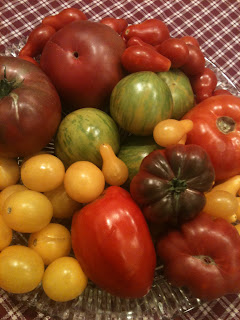Blog entry by Shayla Carey
Every other day, he comes around the cubicle wall and shares some of the informative and witty snippets that will, eventually, go into his books. Sometimes I even get to edit some of his work (although his wife, Susan, does the bulk of the editing during the first read-through). When I have a press release that needs another set of eyes, I can often count on his insight to help me polish my work. It’s like being part of a writing club and is one of the perks of my job.
During my four-year tenure here, Dr. Richman has finished at least three books and is working on another one now with our museum educator, Michael Emery. Titled Roses and Ray Flowers, it promises to be a real feast for the eyes with fascinating information thrown in. He’ll cover roses, daisies and other members of the mum family, zinnias, and wild ray flowers such as black eyed Susans and purple coneflowers. Here are some interesting tidbits for use with illustrations, which led to further research for the book.
The Black Rose
 “The black rose is a legend. All available “black roses” found in nature are actually a deep red. This artist’s version of a black rose is done in watercolor and was painted circa 1950 for use in an advertisement.” The black color can be achieved by dying a lighter flower, much as carnations are dyed by florists. A step by step process is recorded in “3 Easy Techniques to Create Black Flowers” by Gina Kellogg. It is interesting to note that the printing process for this particular illustrated bloom started with a black rose and added pink half-tone to the flower and blue half-tone to the stem (not pictured).
“The black rose is a legend. All available “black roses” found in nature are actually a deep red. This artist’s version of a black rose is done in watercolor and was painted circa 1950 for use in an advertisement.” The black color can be achieved by dying a lighter flower, much as carnations are dyed by florists. A step by step process is recorded in “3 Easy Techniques to Create Black Flowers” by Gina Kellogg. It is interesting to note that the printing process for this particular illustrated bloom started with a black rose and added pink half-tone to the flower and blue half-tone to the stem (not pictured).
Black roses have many different meanings: death, mourning, mystery, etc., but they also have a political meaning as well, as evidenced by the song “Róisín Dubh,” or “Dark Little Rose,” a song sung in Irish that was covered by artists such as Sinead O’Connor and Cherish the Ladies, among others. In the James Clarence Mangan version of the song (“Dark Rosaleen”), Ireland is the black rose and the singer willingly martyrs himself for her, as described in the book, Seamus Heaney and the Emblems of Hope, by Karen Marguerite Moloney. A copy of the poem can be found in the book, The Song Lore of Ireland: Erin's Story in Music and Verse by Redfern Mason.
In an interesting twist, black roses and other dark flowers are becoming popular as bridal bouquets—despite their traditional meaning as the death of a relationship—and the meaning is changing to represent the birth of something new, according to the blog post, “The Meaning of the Color of Roses,” by color expert Kate Smith.
The search for a perfect black rose continues, with cultivars like Black Baccara and Black Jade coming close but requiring close monitoring and patience to achieve their darkest potential. Wiki How has a nice article on growing dark roses, for those who want to cross over into the dark side of gardening.
Daisies
“Lots of Daisies here, ready to be picked. A postcard circa 1910 in the Alice Marshall collection at Penn State Harrisburg in Middletown, PA. In the early years of the 20th century, ‘Daisy’ was a common girl’s name popularized by the song ‘Daisy Bell,’ written by English song writer Harry Dacre in 1892. Everyone could sing the forward,
‘Daisy, Daisy, give me your heart to do
I'm half crazy, hopeful in love with you
It won't be a stylish marriage
I can't afford the carriage
But you look sweet upon the street
On a bicycle built for two’”
While the name never became as popular as Rose was during the early two decades of the 20th century, it held its own until the 1920’s, when it dropped off the list of top 200 names given to babies in America, according to the Social Security Administration. It is one of those enduring floral names used in literature, though. Symbolizing innocence and gentleness—who ever thinks of a hard and bitter nature when imagining a daisy flower?—the name has graced such literary characters as Daisy Miller, a bright and naïve young American lady in Henry James’ novella by the same name; Disney’s sweet and sassy Daisy Duck; little Daisy Armstrong, the true victim in Agatha Christie’s Murder on the Orient Express; and Daisy Buchannan, a hard and selfish woman who proved to be Jay Gatsby’s downfall in The Great Gatsby (a great study in symbolism and the expectations of modern society). More recently, Jessica Tandy became Daisy Werthan in the Oscar winning movie, “Driving Miss Daisy,” and Sophie McShera stars as kitchen maid Daisy Robinson Mason in the popular British drama, “Downton Abbey.” Just thinking about the symbolism attached to the name brings depth to each of these characters, whether it's because they epitomize innocence or because they are the opposite.
Will Daisy ever top the charts of baby names? Probably not in my lifetime, but I believe it will continue to adorn little girls throughout America as long as we believe in hope, innocence, and peace.
For more of Dr. Richman’s writing, pick up a copy of his newest book with Michael Emery, Living Crafts, Historic Tools, at the Landis Valley Museum Store.



